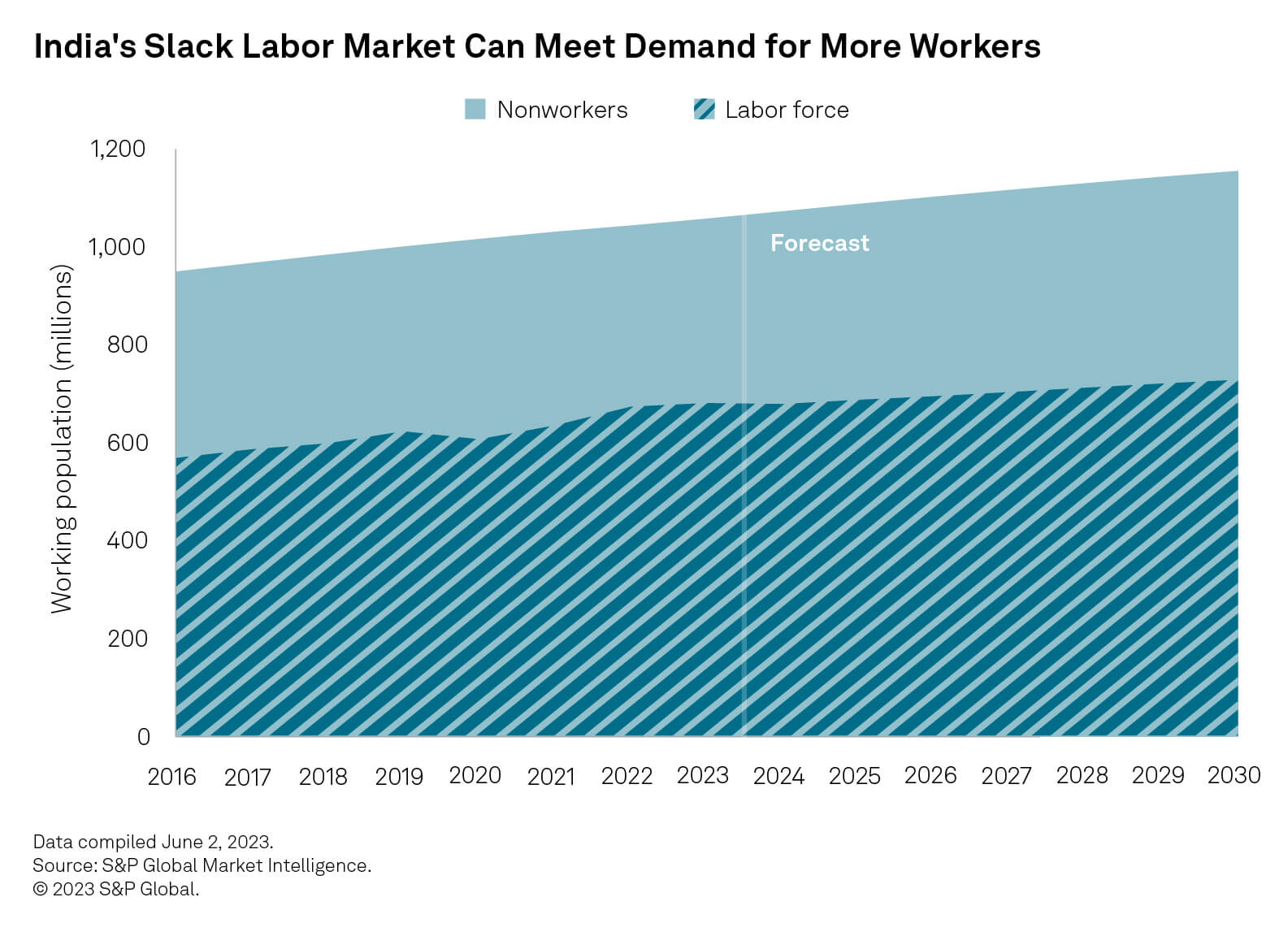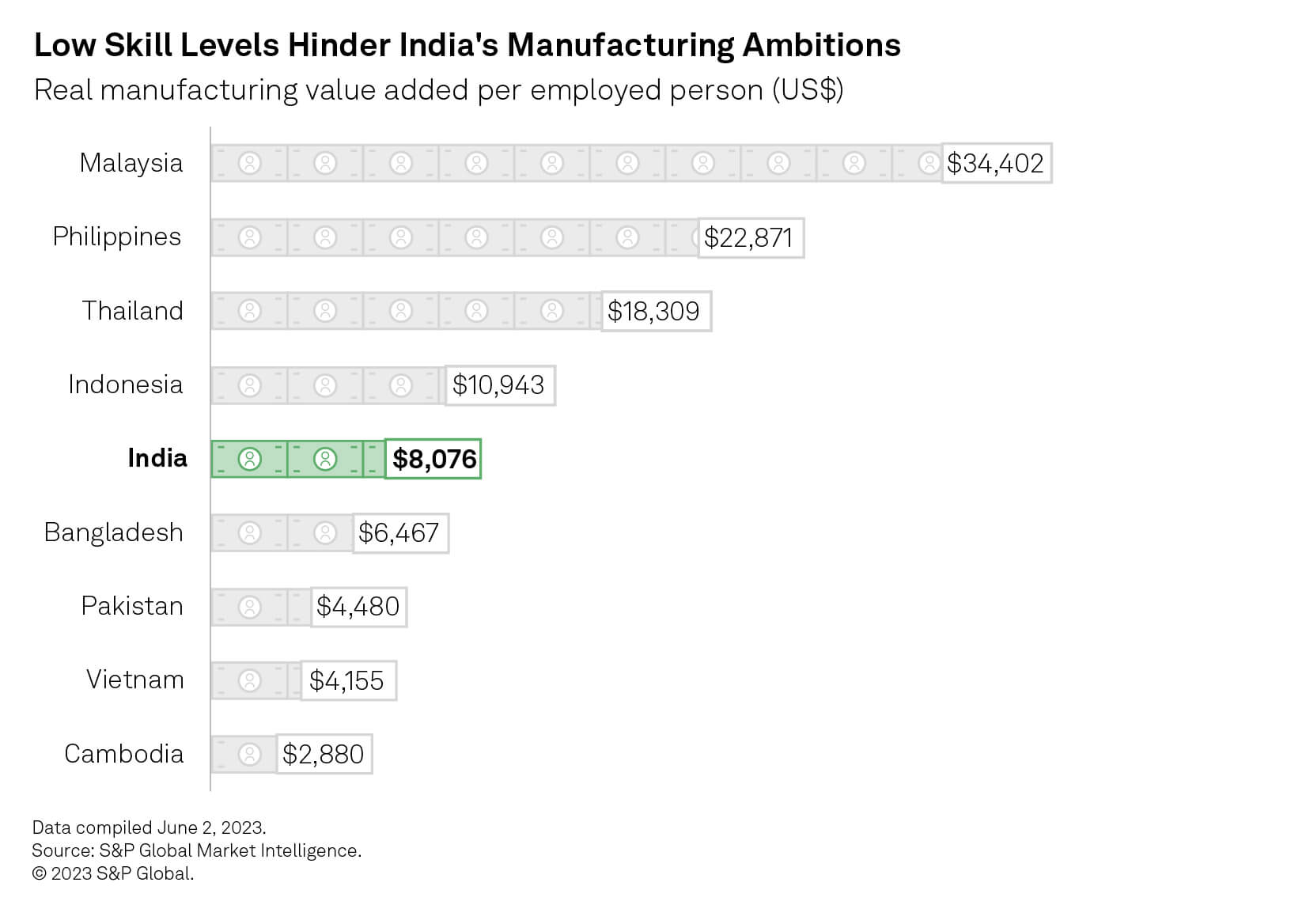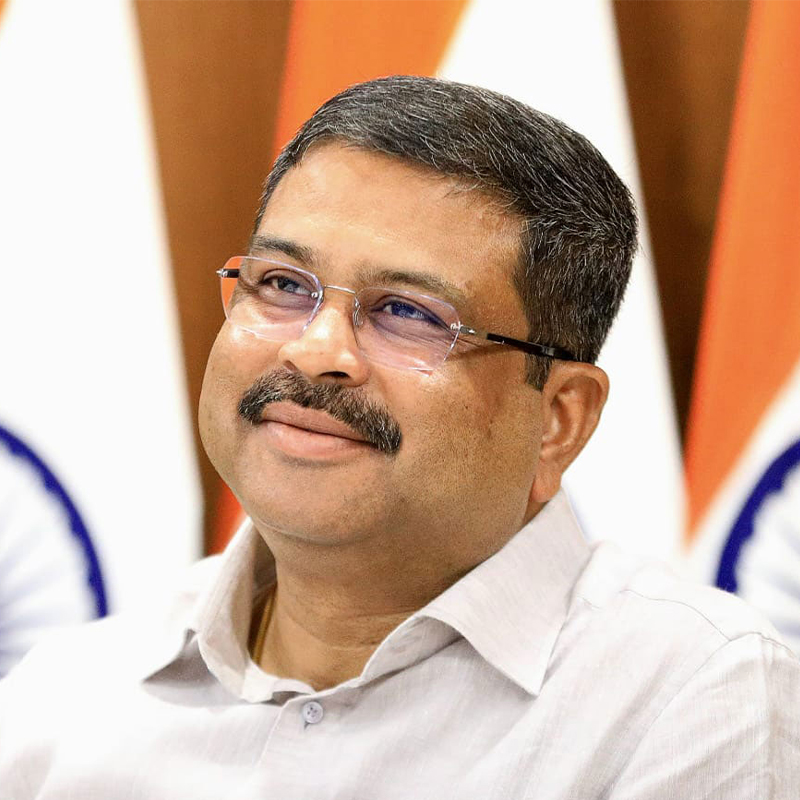Featured Topics
Featured Products
Events
S&P Global Offerings
Featured Topics
Featured Products
Events
S&P Global Offerings
Featured Topics
Featured Products
Events
S&P Global Offerings
Featured Topics
Featured Products
Events
Language
Featured Products
Ratings & Benchmarks
By Topic
Market Insights
About S&P Global
Corporate Responsibility
Culture & Engagement
Featured Products
Ratings & Benchmarks
By Topic
Market Insights
About S&P Global
Corporate Responsibility
Culture & Engagement

Abundant labor supply will fuel India’s near-term growth, but upskilling and the inclusion of women will be crucial in reaching the nation’s economic potential.
Published: August 3, 2023
By Sophie Malin and Ashima Tyagi
Highlights
India’s short-term economic growth will stand on the shoulders of its 678.6 million strong labor force, as estimated by S&P Global Market Intelligence, but labor market reforms could help to unlock sustainable long-term growth.
The nation’s ambitions to become a global manufacturing hub are closely linked to its ability to upskill workers. Progress is already underway, as nearly 10 million youth benefit from the Skill India program annually.
Getting more women to enter the workforce will be pivotal for future growth, as only 24% were participating in 2022, according to International Labour Organization estimates.
India, home to 1.4 billion people, has surpassed mainland China to become the world’s most populous country, according to UN estimates. This gives India potential advantages, especially at a time when countries around the world are facing declining birth rates and tight labor markets. S&P Global Market Intelligence forecasts that India’s population will continue growing over the coming decade. The UN estimates that India’s population will not begin to decline for another four decades.
India’s abundant labor force makes it well placed to achieve domestic growth goals and to capitalize on global efforts to diversify supply chains. Both of these potential outcomes will serve the nation’s geopolitical ambitions well. However, there is a clear need to accelerate labor upskilling and to strengthen women’s participation in the workforce if India is to achieve its economic potential.
The sheer size of India’s workforce is a major competitive advantage as the country tries to become a global design and manufacturing hub. The government’s emphasis on “Make in India, Make for the World” complements this labor advantage by incentivizing marque global companies to invest in Indian manufacturing.
India is currently a services-orientated economy, with 30.7% of the labor force employed in the services sector, according to International Labour Organization (ILO) estimates. Increasing manufacturing’s contribution to national GDP is a challenge. Still, the global drive to strengthen supply chain resilience in the post-pandemic world provides India with an opportunity.
Beyond the size of India’s population, relatively high unemployment and muted labor force participation suggest ample room for increased hiring before labor shortages become a concern.
The nation had an unemployment rate of 9.3% in 2022, surpassing the global average of 6.8%, according to the World Bank. This labor market slack will remain over the coming decade, with unemployment set to average 11.0%, as per S&P Global Market Intelligence forecasts. Labor force participation was also relatively low at 61.4% in 2021, versus a global average of 63.3%, according to the World Bank.
India’s pool of untapped labor presents a long-term advantage as there are marginal workers that could be attracted into the jobs market, easing any potential recruitment pressures. This slack contrasts with concerns about labor shortages in other countries, so it could offer manufacturers some risk mitigation against escalating employment costs.

Indian manufacturing is dominated by low-skilled labor, in contrast to the upskilled workforce found in services. This difference reflects the central government’s focus on services-driven economic growth in recent decades, which has naturally driven higher skill development in this sector. Increasing skill levels in manufacturing would aid India’s efforts to become a global manufacturing hub.
The lower skill level in Indian manufacturing means that each employee added just $8,076 of value on average in 2021, according to S&P Global Market Intelligence. That’s far behind the $18,308 achieved in Thailand and the $34,402 seen in Malaysia. This skills shortage is a key risk for manufacturers wanting to move up the value chain, jeopardizing India’s bid to be a manufacturing hub. Securing talent has been difficult for 79.0% of industrials and materials employers, according to the ManpowerGroup Employment Outlook Survey for the second quarter of 2023.

The government’s decision to establish the Ministry of Skill Development and Entrepreneurship (MSDE) in 2014 demonstrated its intent to address the skills gap. The MSDE’s mandate includes coordination of skills development efforts nationwide and the establishment of a vocational and technical training framework. Prime Minister Narendra Modi also launched the Skill India Mission in 2015, with an ambitious initial target of training 400 million Indians in various skills by 2022. This goal was divided across a number of different programs. One of them, the Pradhan Mantri Kaushal Vikas Yojana (PMKVY) program, has helped 13.7 million individuals receive training since April 2016. The National Skill Development Corporation has acted as a catalyst for PMKVY, working with 538 training partners to set up about 10,000 training centers across 36 sectors.
Government efforts to improve education will also likely provide more skilled workers for manufacturing and other industries. The National Education Policy, announced in 2020, created a comprehensive framework to transform the education system by 2030. A major focus of the initiative is foundational literacy and numeracy. Another key goal is improving the fragmented higher education sector. This could help India attract more high-value and globalized jobs in manufacturing, as well as in other sectors such as research, technology and financial services.
India’s future economic growth will rest heavily on whether governments can boost low labor participation among the nation’s 691.7 million females, based on UN estimates. Just 24.0% of women were working in 2022, according to the ILO, a decline from the already low 27.8% seen in 1990. The drop, even amid greater female education, partly reflects the reduced need for women to work, as higher wages for men have boosted household incomes. A wide range of employment and gender discrimination issues have also deterred women in India from working, as highlighted in a 2015 report by the Ministry of Women and Child Development.
Policies seeking to mitigate gender discrimination and address lingering structural imbalances will enable women to outsource care responsibilities, participate more in higher education and leverage the increasing formalization of work. For instance, the central government’s Mission Shakti program offers safe havens for women at risk of abuse, creche support services, accommodation for working women and gap funding for female entrepreneurs. Vocational training specifically targeted at women of different ages and from different socioeconomic groups is also being offered at 19 National Skill Training Institutes for Women.
Labor dynamics will be pivotal in achieving India’s domestic growth targets and its global ambitions.
A key impediment to overcome will be public perception that upskilling is a last resort for those who have opted out of the formal academic system. This was acknowledged by the government in MSDE’s Annual Report 2021-22. Consolidating and streamlining upskilling schemes may also improve their effectiveness. MSDE has a challenging task in coordinating skill-development programs spread across multiple ministries and associated departments within the central and state governments.
Boosting female labor participation will partly depend upon an evolution in the perception of the role of women in Indian society. This will reduce barriers for women entering the workforce and diminish gender discrimination more broadly.
India’s demographic dividend will help drive the country’s domestic and global ambitions, but appropriate and timely policy interventions will be key in achieving the desired goals.

What does the government see as the public sector’s role in reaping India’s favorable demographic dividend?
India is home to more than 600 million people aged between 18 and 35, with 65% under the age of 35. India’s demographic dividend is expected to persist at least until 2055–56 and will peak around 2041, when the share of the working-age population — 20–59 years — is expected to hit 59%. It is an opportunity which can be harnessed if the right conditions are there or created. Under the leadership of Prime Minister Narendra Modi, we have launched a futuristic National Education Policy (NEP). Experts have found that over 80% of a child’s brain development occurs prior to the age of six years. Based on this, for the first time in India’s history, early childhood care and education have been brought under the formal schooling system. Our government is ensuring that multilingualism is part of NEP. Prime Minister Modi has envisioned India to be the skill capital of the world. We have made tremendous progress at speed and scale in skilling, reskilling and upskilling our youth. We have skilled more than 63.5 million people under various initiatives and have created a network of skill institutes and are encouraging more and more women to take up vocational training.
What does the government envision as the role of entrepreneurship in creating high employment and economic growth? And what is the strategy in education to inspire entrepreneurship?
Our prime minister has called entrepreneurs India’s “growth ambassadors” and has pledged to make India an entrepreneurship hub. With the launch of NEP 2020, the focus has been to shift the mindset of the youth from being jobseekers to job creators. Prime Minister Modi has said that wealth creation is a great national service and there is a need to recognize and encourage wealth creators. India is also setting up laboratories in schools across the country to foster curiosity, creativity and imagination in young minds, as well as to inculcate skills, such as a design mindset, computational thinking, adaptive learning and physical computing. We are also fast setting up and growing a network of incubation centers to promote innovation and entrepreneurship. I say it proudly that today we have the third-largest startup ecosystem in the world and eagerly await to be at the No. 1 spot with our policies and strategies. To give you some statistics, there were more than 90,000 startups in 2022 in India versus less than 1,000 in 2016. We now have over 100 unicorns. Over the years, these unicorns have raised over $94 billion in funding and have a combined valuation of $344 billion. NEP 2020 is driving a wave of change and promoting skill-based education that not only minimizes the social stigma attached to taking up a vocation as a career, but also exposes the youth to multiple career paths, including entrepreneurship.
How will automation and technological developments impact and influence government policies?
Automation and groundbreaking advancements in technology are fundamentally changing the nature of work in more ways than one can think. Trends such as demographic transitions and technological changes such as Industry 4.0, Web 3.0, extended reality technology and AI are bringing immense possibilities that will forever change lives. We need to accept and adapt to these changes and do it fast. It is inevitable that the future of work will be characterized by the collaboration of boundaryless teams that will collapse all barriers to imagination, productivity and creativity. Our ambition is also to make India a global powerhouse for AI. As technology becomes more integrated into governance and public services, ensuring cybersecurity and protecting citizens have also become paramount. Therefore, we are developing robust policies and regulations to safeguard critical infrastructure, protect against cyberthreats and establish frameworks for data privacy and consent. The rapidly evolving future of work will lead to some skills rising in importance whereas some other skills will witness a decline. NEP 2020 provides the opportunity for that alignment.
Interviewed by Sambit Mohanty, Editorial Lead, Petroleum News at S&P Global Commodity Insights. Sambit is based in Singapore.
India’s economy continues to expand as inflation moderates
Inflation trends diverge as service sector growth spurt drives global growth to 16-month high
Global Trade at a Crossroads: As Tensions Escalate, U.S. Companies Try to Diversify Supply Chains Away from China
S&P Global India Manufacturing PMI®
Next Article:
Cooperation and Competition: India’s Evolving Center-State Dynamics
This article was authored by a cross-section of representatives from S&P Global and in certain circumstances external guest authors. The views expressed are those of the authors and do not necessarily reflect the views or positions of any entities they represent and are not necessarily reflected in the products and services those entities offer. This research is a publication of S&P Global and does not comment on current or future credit ratings or credit rating methodologies.

